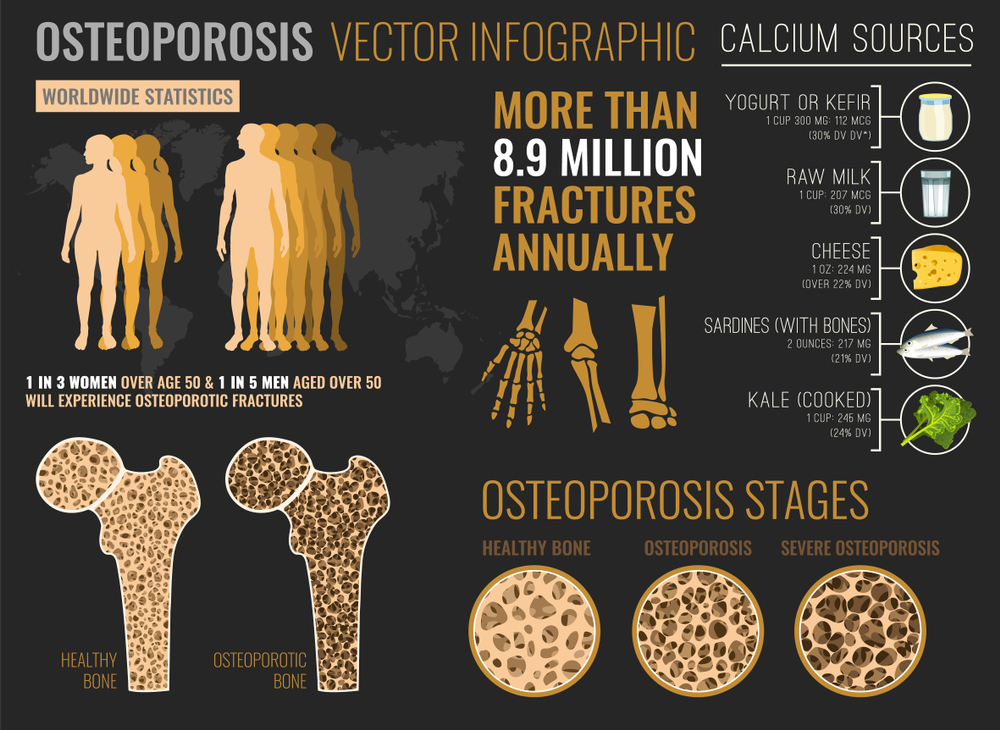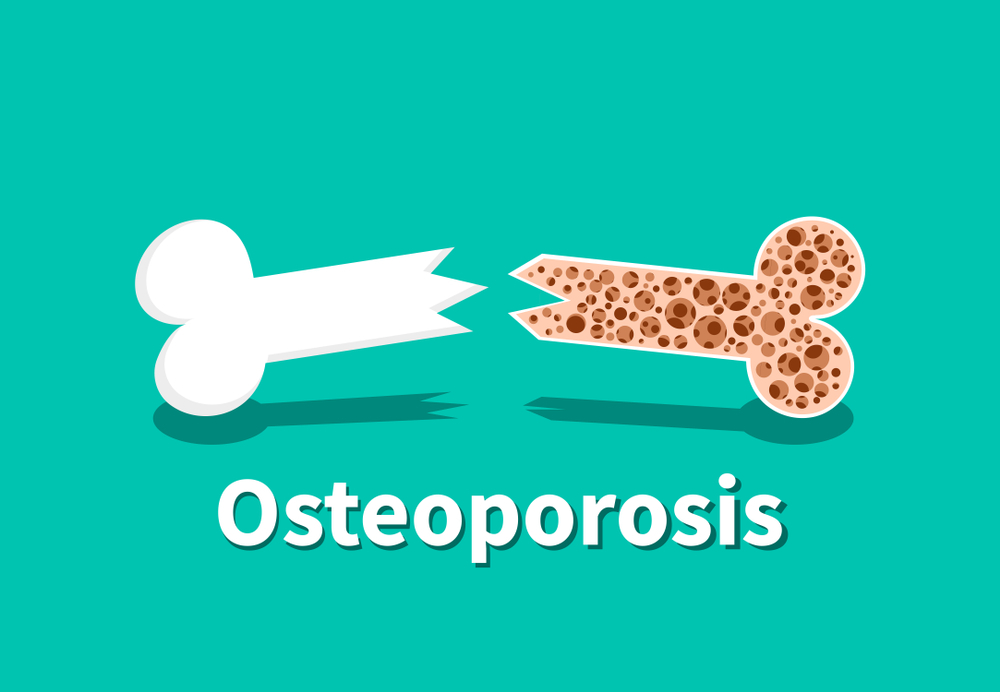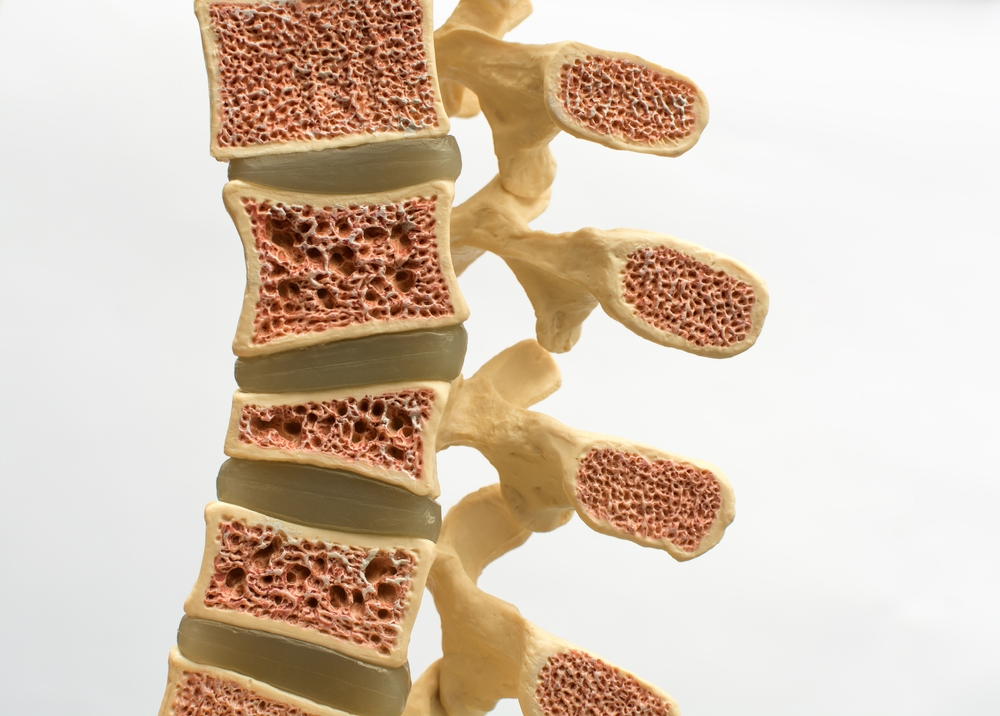Complete Guide on Diagnosing and Treating Osteoporosis In Men
Osteoporosis in Men is a common condition and men are often surprised to learn that they can get osteoporosis, too. Though it’s much more common in women, this bone-weakening disease doesn’t discriminate. About one in 12 men over 50 will break a bone due to osteoporosis.
Osteoporosis happens when minerals like calcium are lost from the bones faster than the body can replace them. It will make the bones weak and porous and more likely to break. Osteoporosis is often called a “silent disease” because there are usually no symptoms in the early stages. By the time osteoporosis is diagnosed, bone loss has already begun.
But the good news is that osteoporosis is preventable, and treatments are available to slow bone loss and reduce fracture risk.
You should be aware of osteoporosis in men if you’re male and over 50. Learn more about the symptoms, treatment, or risk factors associated with osteoporosis in men.
Osteoporosis In Men
Osteoporosis is categorized as primary osteoporosis and secondary osteoporosis. Primary osteoporosis is a prevalent type because it occurs as we age. Certain medications or health conditions can cause secondary osteoporosis.
Osteoporosis in men has one or more secondary causes, often more. In cases of secondary osteoporosis, specific lifestyle choices, illnesses, or medications are to blame for losing bone mass. Men’s exposure to
- Hypogonadism (low testosterone levels)
- Alcoholism
- Smoking
- gastrointestinal disorders,
- hypercalciuria and
- Immobility
It can cause secondary osteoporosis in men.
-
How Our Bones develop
The biological tissue that makes up our bones is constantly developing, regenerating, replacing, and healing.
We gain more bone than we lose from birth to roughly the age of 25. During this period, our bones not only expand to accommodate our growth, but they also gain density. This establishes how powerful they are.
From 25 to 50 years old, our bones break down and heal at about the same rate. They are in a state of balance. At this point, we have reached our “peak bone mass.” Our bones are as healthy as they can be
At around age 50, we begin to lose more bone than we gain. Patients will gain from being informed about their bone health. Our bones gradually lose density and strength, making them more prone to breaking. While everyone loses bone mass as they age, not everyone gets osteoporosis. Osteoporosis is only diagnosed until a specific level of bone loss has occurred.
Below image gives you a facts about the Osteoporosis;

Facts about the Osteoporosis
-
Osteoporotic fractures in men
Typically, bone fracture is the first sign of osteoporosis. Osteoporosis fractures typically affect males later in life than they do women, but this does not mean that the fractures are without risk. In actuality, males are more likely than women to pass away from complications following a hip fracture caused by osteoporosis.
Every year, 80,000 men suffer hip fractures. 60% of men who survive a fracture have a greater risk of getting another fracture. In addition, men are more vulnerable than women to rib fractures as a result of osteoporosis.
Because osteoporosis does not cause discomfort till a fracture has taken place, male patients will benefit from being aware of their bone health because osteoporosis does not produce pain unless a fracture occurs. Males are less likely to seek osteoporosis testing in midlife.
Let us discuss the causes of osteoporosis in men.
Causes of Osteoporosis in men
The causes of osteoporosis in men are not fully understood. However, several risk factors have been identified. Some of these include:
-
A family history of osteoporosis
If you have osteoporosis in your family history, you may be at increased risk for the condition.
-
An inactive lifestyle
A good healthy lifestyle can lead you to a healthy self. People who are not having an active lifestyle are more prone to diseases.
An additional risk factor for osteoporosis is a sedentary lifestyle. You can have weaker bones, which can become brittle if you don’t exercise enough. Be sure to get at least 30 minutes of exercise every day.
-
Smoking
Smoking is terrible for your bones. It increases your risk of osteoporosis and fractures. If you smoke, quitting is the best thing you can do for your bone health.
Research has found that mostly osteoporosis in men occurs when men have poor diets and an increase in smoking consumption.
-
Excessive alcohol consumption
One of the worst beverages a person may consume is alcohol. It causes numerous health issues, and those who become hooked may notice a weakened immune system.
Similarly, drinking too much alcohol can also increase your risk of osteoporosis. If you drink, do so in moderation. Alcohol contains ingredients that can leach calcium from your bones, making them weaker.
-
Certain medical condition
Specific medical disorders may also increase your risk of osteoporosis. These consist of:
- Celiac disease
- Cushing’s disease
- Hyperparathyroidism
- Multiple sclerosis
- Rheumatoid arthritis
- Crohn’s disease
- Type 1 diabetes
-
Poor nutrition
Diet is essential to our lives. Our diet has an impact on every part of our body. As we age, it becomes increasingly crucial to provide the body with the nutrition it needs to function correctly.
That’s why Poor nutrition is another factor that can contribute to osteoporosis. Be sure to eat a healthy diet with plenty of calcium and vitamin D. These nutrients are essential for bone health.
-
Low estrogen level
Both men and women need estrogen to build and maintain healthy bone density. According to research, estrogen deprivation may contribute to osteoporosis in men just as it does in women. Low bone mineral density may be caused by a lack of estrogen, which is found in men at modest levels. However, it is not yet apparent if males with osteoporosis should undergo estrogen level monitoring and maintenance.
Osteoporosis in men is often diagnosed after a bone fracture. You must see your doctor for regular checkups and discuss treatment options if you have osteoporosis. Several efficient treatments can aid in lowering the risk of subsequent fractures.
How to prevent osteoporosis in men
You can take numerous actions to prevent osteoporosis or, at the very least, stop it from getting worse.
First, ensure you get enough calcium and vitamin D in your diet. Calcium helps build strong bones, while vitamin D helps your body absorb calcium. Dairy products, leafy green vegetables, and meals fortified with calcium, like orange juice and cereal, are all the best food for osteoporosis.
Although excessive sun exposure can result in skin cancer, it’s recommended to obtain vitamin D through diet and supplements rather than from sunshine.
- You should make sure you are receiving adequate magnesium, phosphorus, and vitamin K in addition to calcium and vitamin D.These nutrients are crucial for bone health.
- Exercise is another important way to prevent osteoporosis in men. Exercises that include bearing weight, such as running and lifting weights, assist in strengthening bones and reduce bone loss.
- If you smoke, quitting will also help reduce your risk of osteoporosis. Smoking decreases the calcium your body absorbs and speeds up bone loss.
They can help you determine if you’re at risk and recommend steps to prevent the disease. Osteoporosis is a severe condition, but it’s often preventable with lifestyle changes. By acting today, you can contribute to your bones’ long-term health and strength.
How To diagnose Osteoporosis in Men
You can use these five ways to diagnose osteoporosis in men.
1. Get a bone density test.
A bone density test is the most popular method for diagnosing osteoporosis. This examination measures the density of your bones using X-rays. The test’s results are contrasted with a healthy young adult’s bone density.
2. Have a DEXA scan
This test is similar to a bone density test, but it uses a different type of X-ray machine. DEXA scans are more accurate than bone density tests and can be used to diagnose osteoporosis at an earlier stage.
3. Get a CT scan
This test creates a three-dimensional image of your bones. You can use it to diagnose osteoporosis, but it’s not as common as a bone density test or DEXA scan.
4. Have an MRI
This examination makes a precise image of your bones using magnetic waves. You can use it to diagnose osteoporosis just like a CT scan, but the results are unexpected.
5. Have a bone Biopsy
In a Bone biopsy, an expert will take a small bone tissue sample and test for osteoporosis. It’s not as common as other tests, but it can be helpful in some cases.
Treating Osteoporosis In Men
There are several treatments for osteoporosis, but the most important thing you can do is prevent the condition in the first place. You must maintain your calcium and vitamin D levels and exercise regularly.
Some treatments can help prevent further bone loss and reduce your risk of fractures if you already have osteoporosis. These treatments include medications, supplements, and lifestyle changes.
Testosterone Replacement Therapy and Bone Density
As men age, they may experience a decline in testosterone levels, leading to osteoporosis. You can minimize your chances of osteoporosis and improve your bone density with testosterone replacement therapy. Please consult a physician before the treatment.
Testosterone replacement therapy (TRT) is a treatment for osteoporosis. TRT can help to improve bone density and reduce the risk of osteoporosis.
There are several types of testosterone replacement therapies available. These include:
-
Injections
Injections are the most common type of TRT. They are given intramuscularly (IM) or subcutaneously (SC). Gels are applied topically to the skin. Implants are placed under the skin.
-
Gels
Gels and injections are the most effective types of TRT. They are also the most expensive.
-
Implants
Implants are less effective but are cheaper.
-
Patches
Patches are an excellent treatment for osteoporosis as they are a safe and effective treatment for osteoporosis. They can be worn on the body and are very easy to use.
There are several types of patches available. These include:
-Hormone replacement therapy patches
-Testosterone replacement therapy patches
-Calc
Medication For Treatment Of Osteoporosis In Men
Some of the medicines that are used to treat osteoporosis are:
-
Bisphosphonates
These drugs help slow bone loss and reduce the risk of fractures. Some people like to have injections for osteoporosis. Bisphosphonates are taken either by mouth or by injection. Examples of bisphosphonates include alendronate (Fosamax), ibandronate (Boniva), and risedronate (Actonel).
-
Selective estrogen receptor modulators (SERMs)
These medicines reduce the risk of fractures by keeping bones strong. They are taken by mouth. Examples of SERMs include raloxifene (Evista) and lasofoxifene (Fareston).
-
Denosumab
This drug is given by injection and helps slow bone loss. Denosumab is an injection for osteoporosis that is used to relieve the symptoms. It is used in people who can’t take bisphosphonates.
-
Calcium and vitamin D supplements
Calcium and vitamin D are essential nutrients for keeping bones healthy. You may need to take supplements if you don’t get enough of these nutrients in your diet.
Lifestyle Changes for Treating Osteoporosis In Men
Along with medications and other treatments some lifestyle changes can help you feel better more quickly. These can include daily exercise, having a healthy and nutritious diet, etc. These lifestyle changes are given in brief below,
-
Exercise
Exercise is essential for maintaining bone health. It helps build strong bones and slow bone loss. The best exercises for osteoporosis are weight-bearing exercises that force you to work against gravity. These include walking, jogging, and lifting weights.
-
Physiotherapy
Physiotherapy can help with osteoporosis by Improving your balance and coordination to help prevent falls – Increasing your muscle strength – Improving your flexibility – Teaching you how to move your body to protect your bones safely.
-
Smoking cessation
Smoking is terrible for your bones. It increases your risk of osteoporosis and fractures. If you smoke, quitting is the best thing you can do for your bone health. Osteoporosis in men also increases as men are more addicted to smoking.
-
Dietary changes
Certain foods can help keep your bones healthy. The best food for osteoporosis are:
– Dairy products: milk, cheese, and yogurt
– Green leafy vegetables: kale, spinach, and collard greens
– Salmon and other fatty fish
– Soy products: tofu, soy milk, and soybeans
– Fortified foods: cereals, orange juice, and loaves of bread
These are the best foods for osteoporosis that can help keep your bone strong and healthy to prevent osteoporosis.
Conclusion
Osteoporosis is a severe condition that can significantly impact men’s health. Osteoporosis makes your bones weak and brittle. There are great chances of osteoporosis in men, including family history, certain medical conditions, and unhealthy lifestyles.
Furthermore, you can prevent osteoporosis by eating a healthy diet, exercising, not smoking, and getting enough calcium and vitamin D. Physiotherapy is another best way to treat osteoporosis. Here you can find best way to prevent and treat osteoporosis in men, if you get any symptoms it is better to treat it early before it’s too late.
How can you book an appointment?
We aim to see you within 24 hours so contact us to make an appointment either online at www.primphysiocare.co.uk or to find out more information on how we can help you, please call us on 07515280990 or email us primephysiocareluton@gmail.com. We are one of the best clinics whose physios are registered with HCPC, CSP and Physio first as well have enormous experience.
Frequently Asked Questions
Q.Osteoporosis: What is it?
Ans. A disorder called osteoporosis makes bones brittle and flimsy. You may have fractures and other problems due to it.
Q. What are the symptoms of osteoporosis?
Ans. Symptoms of osteoporosis can include:
-Back pain
-Loss of height
-A hunched posture
-Bone fractures
Q. Who is at risk for osteoporosis?
Ans. There are several risk factors for osteoporosis. These include:
-Family history
-Certain medical conditions
-Smoking
-Excessive alcohol consumption
-Poor nutrition
-An inactive lifestyle
Q. What are the treatments for osteoporosis in men?
Ans. There are several treatments for osteoporosis. These include:
-Bisphosphonates
-Denosumab
-Selective estrogen receptor modulators (SERMs)
-Calcium and vitamin D supplements
-Exercise
Q. How to prevent osteoporosis?
Ans. You can take several steps to prevent osteoporosis.
These include:
-Eating a healthy diet
-Getting enough exercise
-Not smoking
-Getting enough calcium and magnesium
consult your doctor about ways you can reduce your risk.
Q. What is the best food for osteoporosis?
Ans. There are several best foods for osteoporosis. These include:
-Dairy products
-Green leafy vegetables
-Nuts and seeds
-Fish
-Fortified foods
These foods are high in calcium and vitamin D, essential for bone health. Be sure to include them in your diet.
Q. Which are the best injections for osteoporosis?
Ans. Several injections are used to treat osteoporosis. These include:
-Bisphosphonates
-Denosumab
-Calcium and vitamin D supplements
These injections help to keep bones strong and reduce the risk of fractures. They are taken by mouth.


